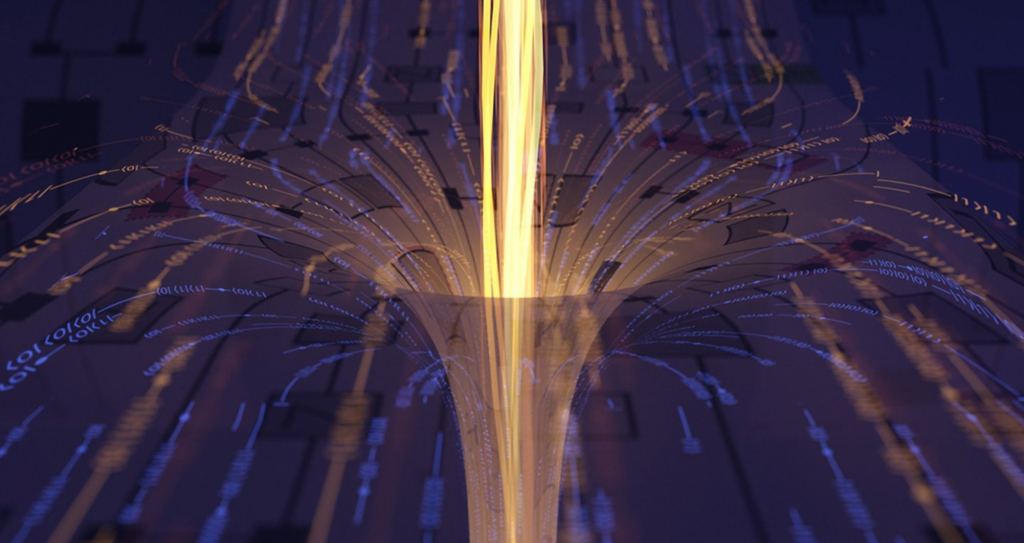For the first time, scientists have created a quantum computing experiment for studying the dynamics of wormholes — that is, shortcuts through spacetime that could get around relativity’s cosmic speed limits. Wormholes are traditionally the stuff of science fiction, ranging from Jodie Foster’s wild ride in “Contact” to the time-bending plot twists in “Interstellar. ” But the researchers behind the experiment, reported in the Dec.
1 issue of the journal Nature, hope that their work will help physicists study the phenomenon for real. “We found a quantum system that exhibits key properties of a gravitational wormhole, yet is sufficiently small to implement on today’s quantum hardware,” Caltech physicist Maria Spiropulu said in a news release. Spiropulu, the Nature paper’s senior author, is the principal investigator for a federally funded research program known as Quantum Communication Channels for Fundamental Physics.
Don’t pack your bags for Alpha Centauri just yet: This wormhole simulation is nothing more than a simulation, analogous to a computer-generated black hole or supernova. And physicists still don’t see any conditions under which a traversable wormhole could actually be created. Someone would have to create negative energy first.
Columbia theoretical physicist Peter Woit warned against making too much of a to-do over the research. “The claim that ‘Physicists Create a Wormhole’ is just complete bullshit, with the huge campaign to mislead the public about this a disgrace, highly unhelpful for the credibility of physics research in particular and science in general,” he wrote on his blog, which is called Not Even Wrong. The main aim of the research was to shed light on a concept known as quantum gravity, which seeks to unify the theories of general relativity and quantum mechanics.
Those two theories have done an excellent job of explaining how gravity works and how the subatomic world is structured, respectively, but they don’t match up well with each other. One of the big questions focuses on whether wormhole teleportation might follow the principles that are behind quantum entanglement. That quantum phenomenon is better understood, and it’s even been demonstrated in the real world, thanks to Nobel-winning research: It involves linking subatomic particles or other quantum systems in a way that allows for what Albert Einstein called “spooky action at a distance.
” Spiropulu and her colleagues, including principal authors Daniel Jafferis and Alexander Zlokapa, created a computer model that applies the physics of quantum entanglement to wormhole dynamics. Their program was based on a theoretical framework known as the Sachdev-Ye-Kitaev model, or SYK. The big challenge was that the program had to be executed on a quantum computer.
Google’s Sycamore quantum processing chip was just powerful enough to take on the task, with an assist from conventional machine learning tools. “We employed [machine] learning techniques to find and prepare a simple SYK-like quantum system that could be encoded in the current quantum architectures and that would preserve the gravitational properties,” Spiropulu said. “In other words, we simplified the microscopic description of the SYK quantum system and studied the resulting effective model that we found on the quantum processor.
” The researchers inserted a quantum bit, or qubit, of encoded information into one of two entangled systems — and then watched the information emerge from the other system. From their perspective, it was as if the qubit passed between black holes through a wormhole. “It took a really long time to arrive at the results, and we surprised ourselves with the outcome,” said Caltech researcher Samantha Davis, one of the study’s co-authors.
The team found that the wormhole simulation allowed information to flow from one system to the other when the computerized equivalent of negative energy was applied, but not when positive energy was applied instead. That matches what theorists would expect from a real-world wormhole. As quantum circuits become more complex, the researchers aim to conduct higher-fidelity simulations of wormhole behavior — which could lead to new twists in fundamental theories.
“The relationship between quantum entanglement, spacetime, and quantum gravity is one of the most important questions in fundamental physics and an active area of theoretical research,” Spiropulu said. “We are excited to take this small step toward testing these ideas on quantum hardware and will keep going. ” In addition to Jafferis, Zlokapa, Spiropulu and Davis, the authors of the Nature paper, titled “Traversable Wormhole Dynamics on a Quantum Processor,” include Joseph Lykken, David Kolchmeyer, Nikolai Lauk and Hartmut Neven.
The post Scientists Send Quantum Data Through a Simulated Wormhole appeared first on Universe Today. .
From: universetoday
URL: https://www.universetoday.com/158896/scientists-send-quantum-data-through-a-simulated-wormhole/



